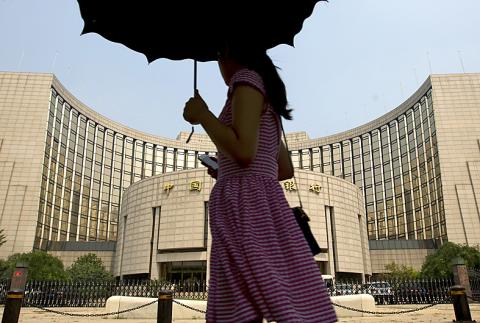China on Friday loosened the means for calculating the reserve requirement ratios of banks, Xinhua news agency reported, effectively increasing the amount of money banks can lend.
The move does not amount to a formal cut in the reserve requirement ratio (RRR), but will allow banks to undershoot it by as much as 1 percent on a daily basis as long as they meet the requirement on average.
Loosening the RRR is also a stimulatory measure as it increases the amount of money banks can lend, which can boost economic activity.

Photo: AP
Earlier this week, the Chinese Ministry of Finance announced that it would accelerate major construction projects, encourage private capital to invest in key areas and cut taxes for small and medium-sized enterprises to support growth.
In another positive move, media reports said that China is preparing to unveil broad reforms for state-owned companies which will see some firms shut and others introduce more diversified ownership.
Friday’s report stated that China’s central bank has changed “its reserve requirement rules, replacing the current daily assessment of bank reserves with an averaged approach,” Xinhua reported.
“Starting from Sept. 15, the reserves of commercial banks will be regulated on an average basis during an assessed period, but there will be a minimum daily amount of reserves, the central bank said in an online statement,” according to Xinhua.
It did not specify over what period the average will be calculated.
By the end of each business day, the reserve ratio of commercial banks will be allowed to be less than 1 percent lower than the compulsory ratio set by the central bank.
The report quoted the People’s Bank of China as saying that the reform will “help commercial banks ensure both efficiency in their capital use and a safe liquidity level.”

IN THE AIR: While most companies said they were committed to North American operations, some added that production and costs would depend on the outcome of a US trade probe Leading local contract electronics makers Wistron Corp (緯創), Quanta Computer Inc (廣達), Inventec Corp (英業達) and Compal Electronics Inc (仁寶) are to maintain their North American expansion plans, despite Washington’s 20 percent tariff on Taiwanese goods. Wistron said it has long maintained a presence in the US, while distributing production across Taiwan, North America, Southeast Asia and Europe. The company is in talks with customers to align capacity with their site preferences, a company official told the Taipei Times by telephone on Friday. The company is still in talks with clients over who would bear the tariff costs, with the outcome pending further

A proposed 100 percent tariff on chip imports announced by US President Donald Trump could shift more of Taiwan’s semiconductor production overseas, a Taiwan Institute of Economic Research (TIER) researcher said yesterday. Trump’s tariff policy will accelerate the global semiconductor industry’s pace to establish roots in the US, leading to higher supply chain costs and ultimately raising prices of consumer electronics and creating uncertainty for future market demand, Arisa Liu (劉佩真) at the institute’s Taiwan Industry Economics Database said in a telephone interview. Trump’s move signals his intention to "restore the glory of the US semiconductor industry," Liu noted, saying that

NEGOTIATIONS: Semiconductors play an outsized role in Taiwan’s industrial and economic development and are a major driver of the Taiwan-US trade imbalance With US President Donald Trump threatening to impose tariffs on semiconductors, Taiwan is expected to face a significant challenge, as information and communications technology (ICT) products account for more than 70 percent of its exports to the US, Chung-Hua Institution for Economic Research (CIER, 中華經濟研究院) president Lien Hsien-ming (連賢明) said on Friday. Compared with other countries, semiconductors play a disproportionately large role in Taiwan’s industrial and economic development, Lien said. As the sixth-largest contributor to the US trade deficit, Taiwan recorded a US$73.9 billion trade surplus with the US last year — up from US$47.8 billion in 2023 — driven by strong

STILL UNCLEAR: Several aspects of the policy still need to be clarified, such as whether the exemptions would expand to related products, PwC Taiwan warned The TAIEX surged yesterday, led by gains in Taiwan Semiconductor Manufacturing Co (TSMC, 台積電), after US President Donald Trump announced a sweeping 100 percent tariff on imported semiconductors — while exempting companies operating or building plants in the US, which includes TSMC. The benchmark index jumped 556.41 points, or 2.37 percent, to close at 24,003.77, breaching the 24,000-point level and hitting its highest close this year, Taiwan Stock Exchange (TWSE) data showed. TSMC rose NT$55, or 4.89 percent, to close at a record NT$1,180, as the company is already investing heavily in a multibillion-dollar plant in Arizona that led investors to assume